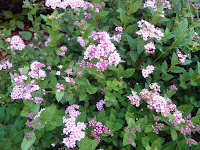Just a few things to consider :)
And while there is tremendous joy, satisfaction and beauty in collecting and growing perennials, vegetables and annuals; it is the trees and shrubs that create the 'backbone' of the landscape. This is the structure that is left when everything else is laid to rest for the season.
I have a real fondness for all the flowering spireas of which there are more than I could shake a finger at. Those wonderful small to mid-sized winter hardy deciduous shrubs that are so happy and easy.
Ok, happy you say? What's that all about? Well, let me tell you.
The foliage comes in an array of color from blue green to chartruese and many varieties provide a wonderful burst of fall foliar displays of burnt orange, reds and yellows. Late spring to summer they flower in reds, pinks and whites and, well, if buterflies love them (and they do) they must be a happy plant.
Now for the easy part (my favorite part). These plants are so forgiving and manageable! You can plant them in just about anything for soil and, provided they get a decent amount of sun, they will prosper and promise to please. They're also not a deal breaker as nursery prices go. Most varities can be purchased in 1 gallon containers (and don't be afraid to buy them small, they'll establish pretty quick) for ~ $15.00.
This is Pink Parasols Spirea aptly named for the soft parasol like blooms that seem to float above attractive blue green foliage.
 |
| Spiraea fritschiana |
But when this little shrub flowers the pink blooms give off this interesting soft almost 'fuzziness' effect.
 |
| Pink Parasols |
Like all spireas, once the flowers go by I simply get out my hedge trimmers and 'deadhead' as well as reshape the shrub back to it's neat little self.
Easy, just the way I love it.
 | |
| Magic Carpet |
In spring the leaf shoots emerge vibrant red, maturing into rich bronze to light green red-tipped foliage.
In fall the foliage takes on nice russet tones. And the pink flowers against that foliage, magic, right?
 |
| Little Princess |
This 'Little Princess' spirea is a dense little plant with even smaller than average leaves. At 2' and as much wide 'Little Princess' can be tucked in just about anywhere, is pest and disease resistant and lives a long, happy, healthy life.
While I realize I've barely scratched the surface of this delightful species, I hope I've instilled enough curiosity for you to go to your local nursery and check out some of the varieties available where you live. ( I think I'll go shopping myself)
You can also check out many of the new exciting varieties online. For example, Nature Hills Nursery has a nice online listing with photos and descriptions.
Once considered the 'poor man's shrub', spireas offer such variety and hardiness that they shouldn't be overlooked.
Check them out. I'm sure you'll find a place for one... or two... or more.
Happy Planting!





